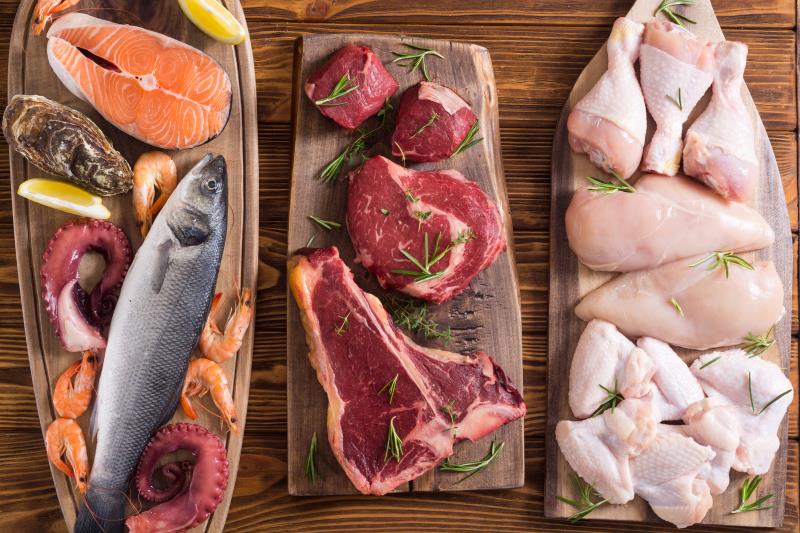
The consumption of processed meat or unprocessed red meat may be associated with a slightly elevated risk of incident cardiovascular disease (CVD)* and all-cause mortality, according to a US study.
The researchers assessed the intake of processed meat, unprocessed red meat, poultry, and fish of 29,682 adults (mean age 53.7 years, 44.4 percent male) who had enrolled in six prospective cohort studies**. A food frequency questionnaire or diet history was used to ascertain dietary intake. Participants consumed a median 1.5, 3.0, 2.0, and 1.6 servings of processed meat, unprocessed red meat, poultry, and fish, respectively, per week.
At baseline, none of the participants had CVD and reported a total calorie intake of 500–6,000 kcal/day. Over a median follow-up of 19 years, 6,963 incident CVD events and 8,875 deaths were recorded.
Each additional two (vs zero) servings/week of processed meat was associated with an elevated risk of incident CVD (adjusted hazard ratio [adjHR], 1.07; p<0.001; 30-year adjusted absolute risk difference [adjARD], 1.74 percent). [JAMA Intern Med 2020;doi:10.1001/jamainternmed.2019.6969]
Similar associations with incident CVD were noted for each additional two (vs zero) servings/week of unprocessed red meat (adjHR, 1.03; p=0.005; adjARD, 0.62 percent) or poultry (adjHR, 1.04; p=0.008; adjARD, 1.03 percent), but not with fish (adjHR, 1.00; p=0.79; adjARD, 0.12 percent).
The association between processed meat intake and incident CVD was stronger in younger participants (HR, 1.17, 1.12, and 1.00 for those aged <45, 45–64, and ≥65 years, respectively; pinteraction=0.008). Stronger associations between unprocessed red meat (HR, 1.06 vs 0.99; pinteraction<0.001) or poultry intake (HR, 1.06 vs 0.98; pinteraction=0.004) with incident CVD were observed in those who consumed a non-high-fat diet compared with those who did not. Individuals who consumed a high-protein diet exhibited a stronger association between fish intake and incident CVD compared with those who did not consume this diet (HR, 0.96 vs 1.02; pinteraction=0.002).
A stronger association between intake of unprocessed red meat and incident CVD was also observed in those who consumed a higher quality diet vs those who did not (HR, 1.09 vs 1.02; pinteraction<0.001), a finding that suggests that those who generally adopt a high-quality diet may also benefit from reducing their intake of unprocessed red meat, the researchers noted.
Intake of processed meat (each additional two vs zero servings/week; adjHR, 1.03; p<0.001; adjARD, 0.90 percent) and unprocessed red meat (adjHR, 1.03; p=0.008; adjARD, 0.76 percent) were significantly associated with all-cause mortality, but not poultry (adjHR, 0.99; p=0.54; adjARD, -0.28 percent) or fish intake (adjHR, 0.99; p=0.18; adjARD, -0.34 percent). These associations were consistent across subgroups assessed.
The researchers acknowledged that lack of information on food preparation methods (eg, fried vs non-fried) may have affected the results. The results also did not account for change in dietary behaviour over the years, with dietary intake assessed using a single measurement. The researchers also noted that the risks of incident CVD and mortality may be higher in individuals who consume more than two servings of processed or unprocessed meats per week, and that the findings may be influenced by additional factors including demographic, genetic, and lifestyle factors.
“Greater intake of a single type of food is not likely independently associated with a substantially higher risk of incident CVD and all-cause mortality,” they pointed out.
“[However,] modifying intake of these animal protein foods may be an important strategy to help reduce the risk of CVD and premature death at a population level,” said study lead author Assistant Professor Victor Zhong from Cornell University, Ithaca, New York, US.
“In spite of the small effect sizes, findings of this study have critical public health implications because dietary behaviours are modifiable and most people consume these four food types on a daily or weekly basis,” said Zhong and co-authors.